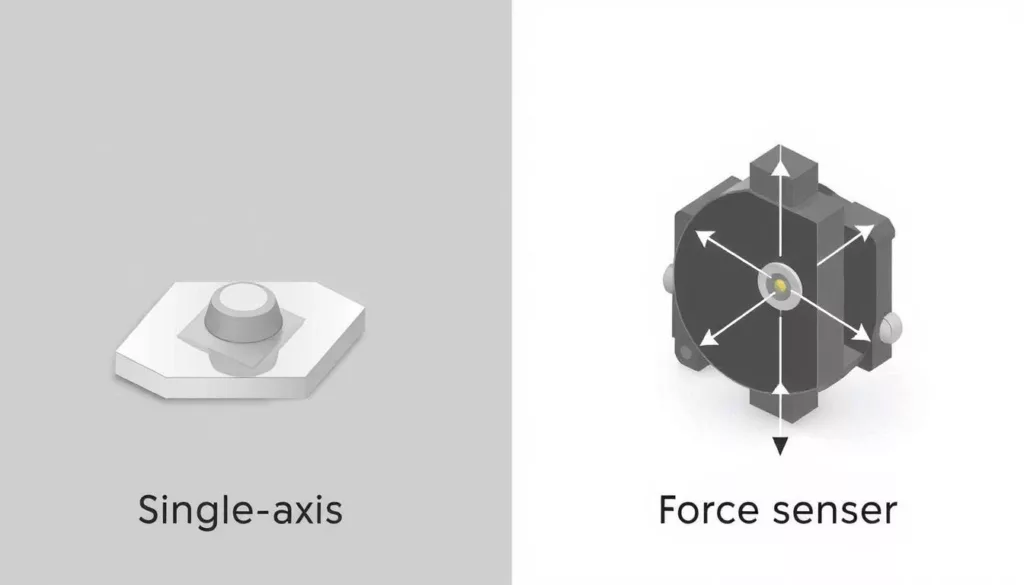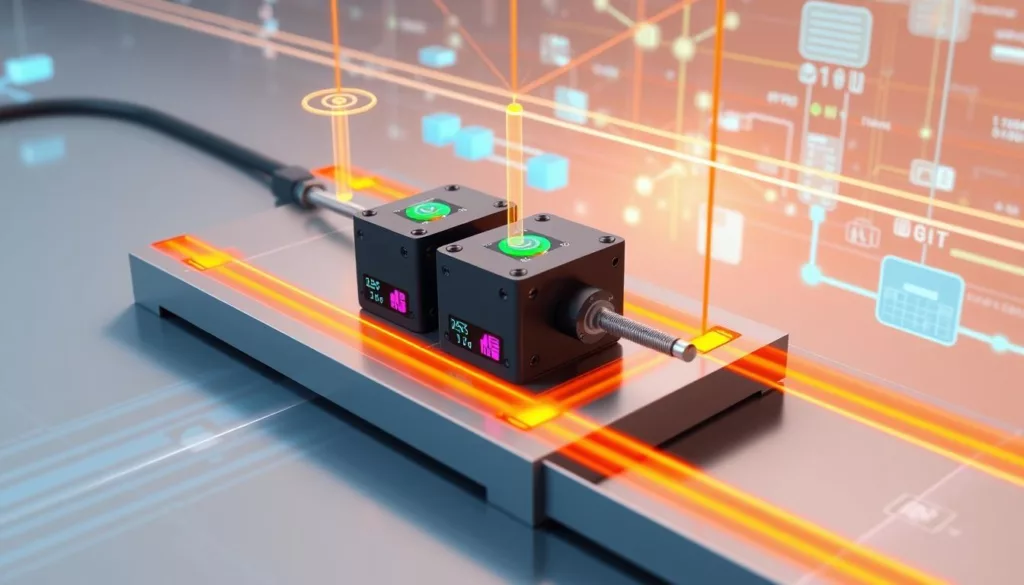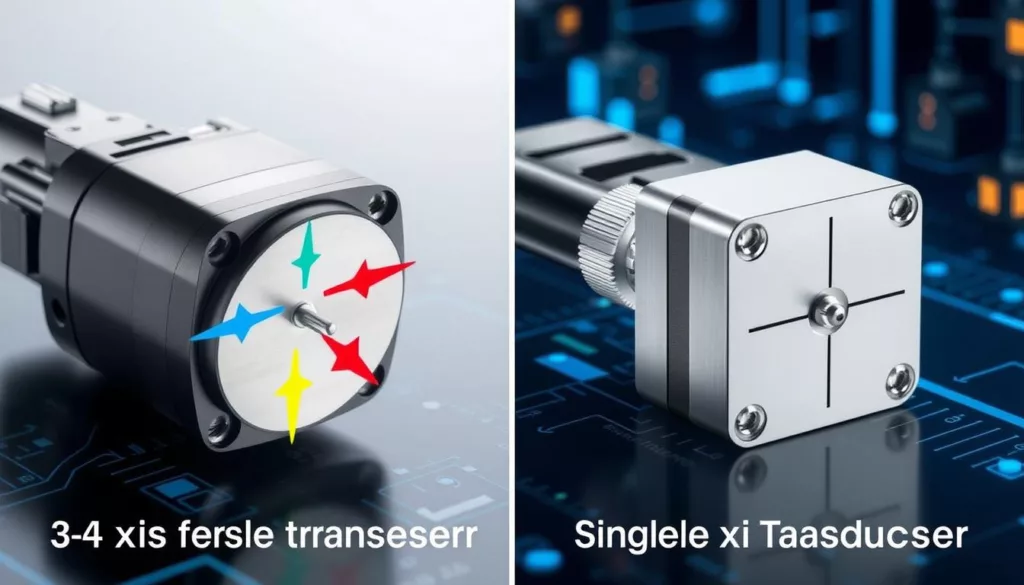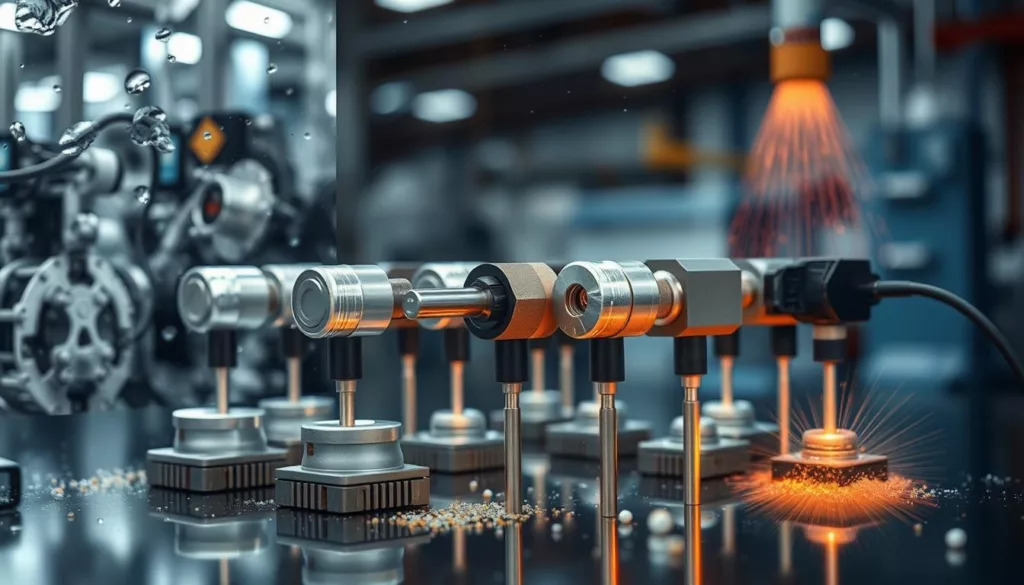In this article, we explore the key differences between 3-Axis vs Single-Axis force sensors. These sensors are vital in many industries to measure force’s strength and direction. Knowing the details of these sensors helps in picking the best one for each job. We’ll look at what makes 3-axis and single-axis sensors special, how they work, and what they can measure.
We aim to give professionals the knowledge to choose the right sensors. The differences between 3-axis and single-axis force sensors are key, mainly in places where accuracy and dependability matter a lot.
Key Takeaways
- 3-axis sensors measure force in multiple directions at once.
- Single-axis sensors are simpler and cheaper for certain tasks.
- Knowing what each sensor can do is key for buying.
- Each sensor has its own strengths for different needs in industries.
- Picking the right sensor can improve performance in cars and healthcare.
Introduction to Force Sensors
Force sensors are advanced tools that measure the force on an object. They are key in many fields like cars, space, robots, and making things. These sensors help ensure everything works well and safely by giving accurate readings.
There are single-axis and multi-axis force sensors. Single-axis sensors measure force in one direction. Multi-axis sensors can track forces in many directions at once. This makes them very useful in different situations.
Using force sensors in work can lead to better quality and safety. It’s important for those in the field to know how these sensors work and their uses.
Understanding Force Sensor Technology
Force sensor technology turns mechanical force into an electrical signal. This is done through piezoelectric, strain gauge, and capacitive methods. Each method has its own benefits, making it key to know the differences between 3 axis and single-axis sensors.
Piezoelectric sensors use materials that create an electric charge under mechanical stress. They are fast and good for quick force measurements. Strain gauges, by contrast, detect resistance changes under force, perfect for steady situations. Capacitive sensors measure capacitance changes caused by force, influenced by material and size.
Each method has its own strengths and weaknesses. Choosing the right sensor depends on the application. Our detailed look at these technologies shows how 3 axis and single-axis sensors differ in use.
| Sensor Type | Measurement Method | Response Time | Best Use Cases |
|---|---|---|---|
| 3 Axis Force Sensor | Piezoelectric | Fast | Dynamic applications |
| Single-Axis Force Sensor | Strain Gauge | Moderate | Static applications |
| Capacitive Sensor | Capacitance Change | Moderate to Fast | Various applications |
Knowing these differences highlights the need to match sensor choice with application needs.
Differences between 3-Axis vs Single-Axis Force Sensors
It’s important to know how different force sensors work and what they measure. This section talks about the main differences between 3 axis and single-axis force sensors. We’ll look at what they do, how they work, and where they’re used.
Definition and Functionality
Single-axis force sensors measure force in just one direction. On the other hand, 3-axis sensors measure force in three directions—X, Y, and Z. This lets us understand forces in a more detailed way.
Because of this, 3-axis sensors are better for complex tasks. They’re used in robotics and precision engineering. Single-axis sensors are good for simpler tasks where forces are mostly in one direction.
Measurement Capabilities
3-axis force sensors can measure forces in multiple directions. This gives them big advantages in certain fields. Here are some of those advantages:
- Enhanced accuracy: Measuring in multiple axes means more accurate readings, even in moving environments.
- Complex force detection: These sensors can handle forces in different directions, which is key for many technical tasks.
- Versatility: 3-axis sensors can handle a wide range of tasks, making them versatile for many industries.
Single-axis sensors are reliable for simpler setups. The choice between these sensors depends on the task’s needs. Looking at the comparison of force sensor types helps choose the right one for the job.
| Feature | 3 Axis Force Sensor | Single-Axis Force Sensor |
|---|---|---|
| Measurement Axes | X, Y, Z | 1 |
| Applications | Robotics, Aerospace, Complex Forces | Basic Force Measurement |
| Accuracy | High | Moderate |
| Complexity | Advanced | Simple |
Multi-Axis Force Measurement Explained
Multi-axis force measurement is a big step forward in understanding how forces work in different systems. It lets us measure forces in many directions at once. This helps in many fields, like robotics and building design.
Concept of Multi-Axis Measurement
This idea is about measuring forces in different directions at the same time. It helps engineers design systems that work well and are easy to control. Tools for multi-axis force measurement make sure loads are balanced right, making machines work better and last longer.
Types of Multi-Axis Sensors
Knowing about the different types of multi-axis sensors is key to picking the right one for your needs. Here, we look at some common ones and what they can do:
| Sensor Type | Operating Principle | Key Features | Applications |
|---|---|---|---|
| Fiber Optic Sensors | Light transmission changes with force | High sensitivity, immunity to electromagnetic interference | Structural health monitoring, aerospace |
| Resistive Sensors | Change in resistance with applied force | Cost-effective, simple integration | Robotics, manufacturing |
| Capacitive Sensors | Capacitance variation with distance changes | High precision, suitable for small displacements | Precision measurement, automotive testing |
Comparison of Force Sensor Types
Looking at different force sensor types can give us important insights. We learn about their strengths and how they work in various settings. Here are some key points to think about when picking a sensor type:
- Cost and Complexity: Single-axis sensors are simpler and cheaper. They’re great for basic tasks where detailed measurements aren’t needed.
- Durability and Environment: The choice between sensor types often depends on the environment. Single-axis sensors usually handle tough conditions like vibration and humidity better than multi-axis ones.
| Aspect | Single-Axis Sensors | Multi-Axis Sensors |
|---|---|---|
| Cost | Lower cost | Higher cost |
| Complexity | Less complex setup | More complex setup |
| Durability | Generally more durable | Can be less durable |
| Environmental Suitability | Works well in various environments | May require specific conditions |
Single-axis force sensors have clear advantages. They help professionals make better choices for their specific needs.
3 Axis vs Single-Axis Force Transducers
In the world of force measurement, 3 axis vs single-axis force transducers are key. Knowing their strengths helps you pick the right sensor for your needs.
Application Areas for 3 Axis Sensors
3 axis force sensors handle forces from different directions. They’re used in many fields, like:
- Robotics: They help robots move and feel forces accurately.
- Aerospace: They track forces in flight, which is critical for safety.
- Automotive: They help in crash tests and safety checks.
- Medical devices: They help in surgeries and patient care.
They’re great for places where forces change a lot.
Advantages of Single-Axis Force Sensors
Single-axis sensors are simpler and cheaper than 3 axis ones. They’re good for:
- Cost-Effective: They’re cheaper for specific tasks.
- Simplicity: They’re easy to set up and use.
- Focused Measurements: They’re best when forces come from one direction.
- Durability: They can handle tough conditions and last longer.
They’re great for simple tasks where you only need to measure one direction. Think about what you need to decide which is best for you.
| Sensor Type | Measurement Capability | Application Examples | Cost Efficiency |
|---|---|---|---|
| 3 Axis Force Sensor | Multi-directional force measurement | Robotics, Aerospace, Automotive | Higher initial investment |
| Single-Axis Force Sensor | Unidirectional force measurement | Packaging, Material Testing, Weighing | Lower initial investment |
Force Sensor Accuracy and Performance
The precision of a force sensor is key to reliable measurements in many fields. To boost accuracy and performance, several factors need attention.
Calibration is essential; it keeps sensors accurate, even in complex systems. Regular checks ensure readings match real forces, aiding in precise calculations.
Environmental changes can harm force sensor tech. Temperature, humidity, and pressure shifts can skew results. Proper installation and upkeep help keep measurements true.
| Factor | Impact on Accuracy | Recommended Actions |
|---|---|---|
| Calibration | Ensures consistent readings | Regular recalibration schedules |
| Temperature Fluctuations | Can cause drift in readings | Install in stable environments |
| Humidity | Affects electronic components | Use environmental seals |
| Pressure Variance | Alter measurement outcomes | Compensate in design |
Knowing these factors helps professionals improve their force sensor systems. This leads to better results in real-world use.
Factors in Selecting the Right Force Sensor
Choosing the right force sensor is key for top performance in many areas. Knowing your project’s needs helps us make smart choices. This boosts efficiency and reliability.
Considerations for Application Needs
When picking a force sensor, several important metrics must be checked:
- Load Capacity: Make sure the sensor can handle the maximum force needed.
- Sensitivity: See how well the sensor reacts to small force changes.
- Responsiveness: Check how fast the sensor gives readings after force is applied.
It’s vital to understand these factors for your specific needs. Learn more about different technologies in our guide on force sensors and strain gauges.
Environmental Factors to Keep in Mind
Environmental factors greatly affect a force sensor’s durability and performance. Consider these:
- Moisture Exposure: Pick sensors that can handle high humidity or water.
- Temperature Extremes: Check the sensor’s operating range to ensure it works well in different temperatures.
- Mechanical Shock: Find sensors with protection against impacts that could mess with readings.
Choosing durable sensors for tough conditions is essential for their long life. By keeping these factors in mind, you can pick the best force sensor for each situation.
Applications of 3 Axis Force Sensors
3-axis force sensors are very versatile. They are perfect for many industrial uses. They give important data, making things work better and safer in different fields.
- Robotics: These sensors help robots move and handle loads better. This makes robots more reliable and efficient.
- Automotive Testing: In car testing, 3-axis force sensors check how cars perform in crashes and tests. They help make cars safer and better.
- Industrial Automation: These sensors watch over machines and adjust them as needed. This makes production lines run smoother and cuts down on downtime.
These applications of 3 axis force sensors are key in today’s engineering. They show how far this technology can go. Using force sensors in these areas is a big step towards more automated and data-driven work.
| Application Area | Benefits | Impact on Industry |
|---|---|---|
| Robotics | Increased accuracy in load handling | Enhanced operational efficiency and safety |
| Automotive Testing | Improved vehicle safety and performance data | Better design processes and compliance with regulations |
| Industrial Automation | Real-time performance monitoring | Reduction in operational costs and enhancement of productivity |
Conclusion
We’ve looked at the main differences between 3-axis and single-axis force sensors. These sensors are key in many industries, helping measure forces accurately. This is important for improving how things work in many areas.
Knowing how these sensors work helps us at XJCSENSOR give better solutions. We make sure our products fit what our clients need exactly.
Understanding what each sensor can do helps professionals choose the right one. This choice is key to making sure tasks are done well and safely. It’s all about making things more precise and reliable.
We keep working on new ideas and staying up-to-date with our knowledge. Our goal is to help make industries more efficient. We want to be leaders in force sensor technology.
If you want to learn more about picking the right sensors, check out our guide on force and torque sensors.





